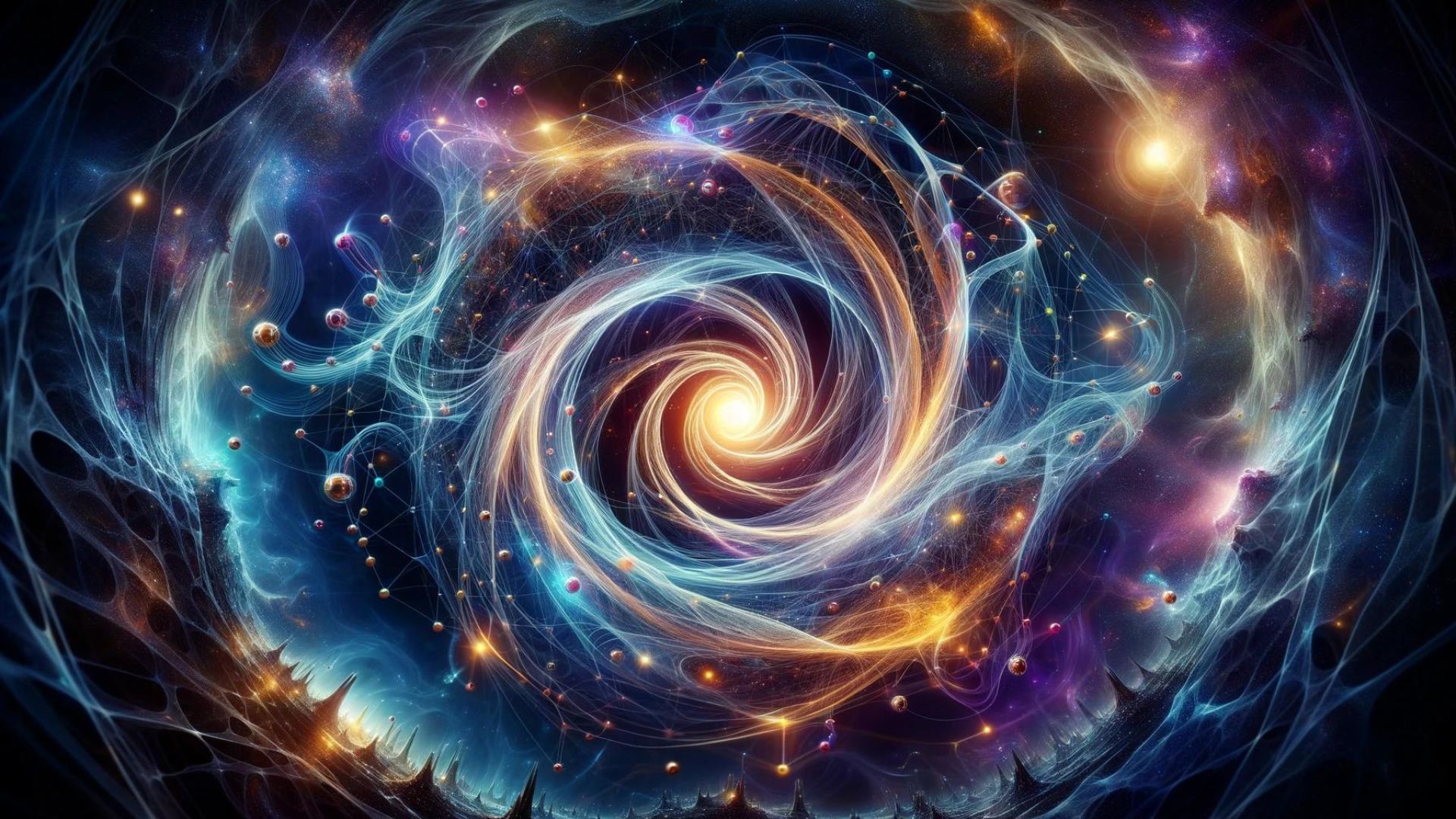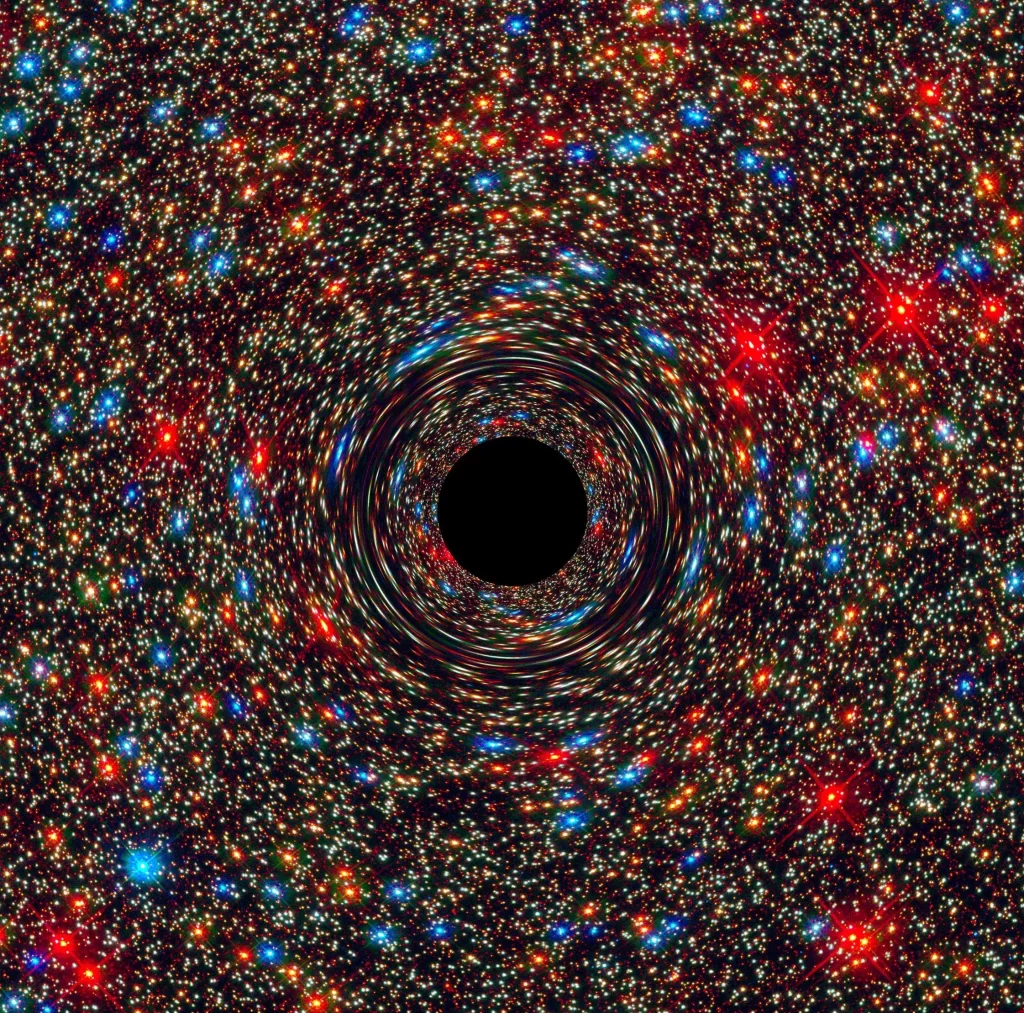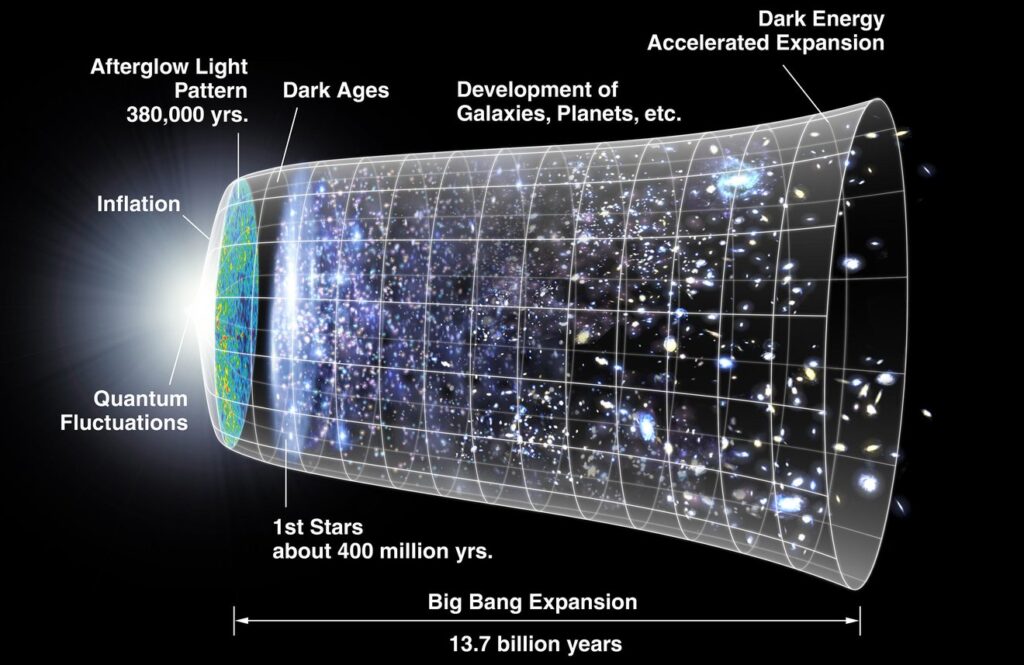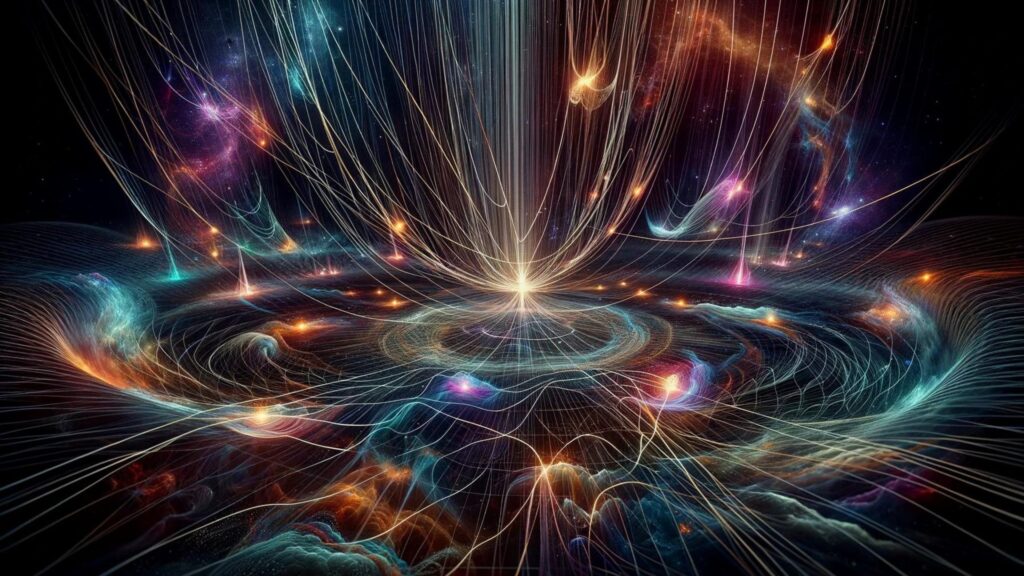Table of Contents
A New Perspective on Reality: The Birth of a Revolutionary Theory
String theory emerged in the late 20th century as a revolutionary attempt to unify the fundamental forces of nature. Traditional physics describes the universe using particles like electrons, quarks, and photons, which interact through forces such as gravity and electromagnetism. However, physicists struggled to reconcile Einstein’s theory of general relativity, which explains gravity, with quantum mechanics, which governs tiny subatomic particles. This theory proposes that, instead of being point-like, these fundamental particles are actually tiny vibrating strings. The unique vibration pattern of each string determines its properties, such as mass and charge. This idea promised a unified framework that could explain all known forces, including gravity, at the smallest scales.
The implications of string theory extend beyond unifying forces; it also suggests the existence of multiple dimensions beyond the familiar three spatial dimensions and time. For instance, this theory posits that there could be up to 11 dimensions, which are compactified and not directly observable. This concept has inspired numerous theoretical developments and experimental pursuits in physics. By proposing that all particles are manifestations of one-dimensional strings, this theory offers a potential solution to the long-standing conflict between general relativity and quantum mechanics. This groundbreaking perspective continues to drive research and debate within the scientific community.
The Building Blocks: How Strings Replace Particles
In classical physics, elementary particles like electrons and quarks are thought of as tiny dots with no size. However, string theory suggests that these particles are actually minuscule, one-dimensional loops or open strands of string. These strings can oscillate in different ways, much like a guitar string playing different notes. Each oscillation mode corresponds to a different particle, meaning that everything in the universe is just a different vibration of the same fundamental entity. Unlike previous theories, which required separate explanations for different forces and particles, this theory presents a single, elegant framework where all particles emerge from the same fundamental structure. This idea fundamentally changes how we perceive matter and forces at the most microscopic level.
This idea fundamentally changes how we perceive matter and forces at the most microscopic level. String theory not only unifies the various particles but also provides a potential explanation for the fundamental forces of nature. By describing particles as different vibrational modes of strings, it offers a cohesive way to understand the interactions between them. This unification extends to gravity, electromagnetism, and the strong and weak nuclear forces, all of which can be described within the framework of this theory. This revolutionary perspective continues to inspire physicists to explore the deeper implications of this theory, pushing the boundaries of our understanding of the universe.
Dimensions Beyond Our Senses: The Extra Hidden Realities
One of the most startling predictions of string theory is that our universe has more than the three spatial dimensions we experience daily. According to the theory, strings require at least 10 spatial dimensions (plus time) to be mathematically consistent. These extra dimensions are theorized to be curled up or “compactified” into incredibly tiny shapes, making them invisible to us. Some models suggest these dimensions could be curled into intricate structures known as Calabi-Yau manifolds, where the geometry dictates the fundamental properties of particles and forces. Although we cannot directly observe these extra dimensions, they play a crucial role in allowing this theory to unify the laws of physics in a coherent manner.
The concept of extra dimensions fundamentally changes our understanding of the universe. While we experience only three spatial dimensions, this theory posits that the additional dimensions are compactified at scales so small that they are beyond our current observational capabilities. These hidden dimensions could potentially explain phenomena that are not accounted for by traditional physics. For example, the behavior of gravity at microscopic scales might be influenced by these extra dimensions. By incorporating these hidden realities, string theory provides a framework that could reconcile general relativity with quantum mechanics, offering a more complete picture of the fundamental forces and particles that make up our universe.
Unifying the Flavors of Theories
Over time, physicists discovered that there were multiple versions of this theory, each with slightly different properties. These variations include Type I, Type IIA, Type IIB, heterotic SO(32), and heterotic E8×E8. Each of these theories describes a different way in which strings can behave and interact with forces like gravity and electromagnetism. Initially, this fragmentation seemed like a problem—if string theory is supposed to be a “theory of everything,” why should there be multiple versions? However, in the mid-1990s, physicist Edward Witten and others discovered that these different string theories were actually connected through a more profound framework known as M-theory, which suggests an even deeper unity among all versions of the theory.
This discovery of M-theory was groundbreaking because it indicated that the various string theories were not separate entities but different aspects of a single, overarching theory. M-theory posits that these different string theories are connected through dualities, which are mathematical transformations that reveal the equivalence between seemingly distinct theories. This unification under M-theory suggests that all string theories are manifestations of a single, eleven-dimensional framework. By incorporating these different flavors of string theory, M-theory provides a more comprehensive understanding of the fundamental forces and particles in the universe. This deeper unity continues to inspire physicists to explore the potential of string theory to explain the fundamental nature of reality.

Superstrings and Supersymmetry: Balancing the Forces
A key feature of string theory is supersymmetry, which predicts that every known particle has a heavier “superpartner” counterpart. This means that for each fundamental particle, such as an electron or quark, there exists a related, yet undiscovered, superparticle like a selectron or a squark. Supersymmetry helps solve major issues in physics, such as why gravity is so weak compared to other forces and how the fundamental forces unify at high energies. For example, the electron’s superpartner, the selectron, would share similar properties but have a much greater mass. While no superparticles have yet been found in experiments like those at the Large Hadron Collider, their discovery would provide significant evidence supporting string theory.
If proven, supersymmetry could help explain mysteries like dark matter, which makes up most of the universe’s mass but remains invisible to us. Dark matter is thought to interact weakly with ordinary matter, making it difficult to detect directly. Supersymmetric particles are prime candidates for dark matter, as their properties align with what is expected of dark matter particles. By incorporating supersymmetry, string theory not only aims to unify the fundamental forces but also offers potential solutions to some of the most profound questions in cosmology. This dual capability makes string theory a compelling framework for understanding the universe at both the smallest and largest scales.
The Vast Landscape of Possibilities
One of the biggest challenges facing string theory is that it does not predict a single unique universe but rather a vast “landscape” of possible universes. Different ways of compactifying the extra dimensions lead to different physical laws, potentially explaining why our universe has the specific laws we observe. For instance, the shape and size of these compactified dimensions can result in varying constants of nature, such as the strength of gravity or the charge of an electron. Some physicists suggest that our universe is just one of many in a multiverse, each with its own unique properties. While this idea is speculative, it could provide an explanation for why our universe appears so finely tuned for life.
If the multiverse is real, our universe may simply be one of countless possible outcomes of string theory’s equations. This concept implies that there could be universes with entirely different physical laws, where life as we know it might not exist. The idea of a multiverse also raises questions about the nature of reality and our place within it. By exploring the string theory landscape, physicists hope to understand why our universe has the particular properties it does and whether these properties are a result of chance or necessity. This ongoing research continues to push the boundaries of our understanding, offering a glimpse into the profound possibilities that string theory presents.
Solving the Black Hole Paradox
String theory has made significant contributions to understanding black holes, particularly in resolving long-standing paradoxes. Classical physics predicts that information falling into a black hole is lost forever, violating the principles of quantum mechanics. However, string theory provides a framework where black holes are composed of strings and branes (higher-dimensional membranes), allowing information to be encoded in subtle ways. This insight, pioneered by Stephen Hawking and later refined by string theorists, suggests that black holes do not destroy information but rather store it in a complex manner. For example, the information might be encoded on the event horizon of the black hole, a concept known as the holographic principle.
This perspective fundamentally changes our understanding of black holes and their role in the universe. The idea that information is preserved rather than destroyed aligns with the principles of quantum mechanics, which state that information must be conserved. String theory’s approach to black holes also supports the concept of quantum entanglement, where particles remain connected even when separated by vast distances. This connection could help explain how information is retained in black holes. By offering a coherent framework that reconciles general relativity with quantum mechanics, string theory provides a promising avenue for solving one of the most profound puzzles in modern physics.

Bridging the Divide Between Physics Theories
One of string theory’s greatest promises is that it naturally includes gravity, something no other quantum theory has successfully done. Traditional physics has struggled to reconcile Einstein’s theory of general relativity, which describes gravity at large scales, with quantum mechanics, which explains particles at the smallest scales. String theory solves this problem by predicting a specific vibration mode corresponding to the graviton, the hypothetical quantum particle of gravity. For instance, the graviton would mediate the force of gravity in the same way that photons mediate electromagnetism. If the graviton were detected, it would provide strong evidence for string theory and offer a long-sought quantum theory of gravity.
This could help explain fundamental cosmic questions, such as what happened before the Big Bang or what truly occurs at the center of a black hole. The unification of gravity with quantum mechanics through string theory could provide insights into the nature of spacetime and the origins of the universe. For example, understanding the behavior of gravitons could reveal how gravity operates at the quantum level, potentially leading to breakthroughs in our comprehension of black holes and the early universe. By bridging the divide between these two major theories, string theory offers a promising framework for addressing some of the most profound mysteries in physics.
A New Perspective on the Big Bang
Traditional cosmology describes the Big Bang as the moment when the universe expanded from an infinitely small singularity. However, singularities present major mathematical challenges, as physics breaks down at such extreme conditions. String theory offers an alternative explanation, suggesting that the early universe may have been a highly energetic state of vibrating strings. This perspective eliminates the need for a singularity, proposing instead that the universe’s initial state was a dense, hot configuration of strings. Some models even propose that our universe was created from the collision of higher-dimensional branes, leading to the observable cosmic expansion. These ideas, while still theoretical, provide a fresh approach to understanding the origins of space, time, and matter.
This new perspective on the Big Bang could help resolve some of the fundamental issues in cosmology. For instance, the collision of branes in string theory might explain the uniformity of the cosmic microwave background radiation, a remnant of the early universe. Additionally, the concept of vibrating strings offers a way to integrate quantum mechanics with general relativity, potentially solving the inconsistencies between these two pillars of modern physics. By reimagining the Big Bang through the lens of string theory, scientists can explore new avenues for research and gain deeper insights into the universe’s birth and evolution. This ongoing exploration continues to push the boundaries of our understanding of the cosmos.

The Experimental Hurdles
Despite its mathematical elegance, string theory remains unproven due to the lack of direct experimental evidence. The predicted strings are incredibly tiny—smaller than any particle we can currently detect—making it difficult to test the theory with modern technology. For instance, the energy scales required to observe these strings directly are far beyond the capabilities of current particle accelerators. Some indirect tests, such as the search for supersymmetry at particle colliders or gravitational waves from cosmic strings, are ongoing. These experiments aim to find evidence that could indirectly support string theory by confirming its predictions about the behavior of particles and forces at high energies.
Additionally, researchers are exploring how string theory might be tested through high-energy cosmic phenomena or precise measurements of black hole behavior. For example, studying the radiation emitted by black holes could provide insights into the fundamental nature of gravity and quantum mechanics, potentially offering indirect evidence for string theory. Another approach involves examining the cosmic microwave background for signatures of cosmic strings, which are hypothetical one-dimensional defects in spacetime predicted by the theory. However, until definitive evidence is found, string theory remains a compelling but unverified theory of reality. This ongoing quest for experimental validation continues to drive advancements in both theoretical and experimental physics.
The Debate Over Modern Theories
String theory has faced criticism for its lack of testability and its reliance on mathematical beauty rather than empirical data. Some physicists argue that it may not be the ultimate theory of nature and that alternative approaches, such as loop quantum gravity, might offer better explanations for quantum gravity. Loop quantum gravity, for instance, attempts to quantize spacetime itself, providing a different approach to understanding gravity at the quantum level. Others point out that the vast landscape of possible universes makes string theory difficult to falsify, a key requirement for scientific theories. This vast landscape implies that almost any observation could be compatible with string theory, making it challenging to test its predictions rigorously.
Despite these challenges, string theory continues to inspire research and provides valuable mathematical tools used in other areas of physics, including condensed matter and quantum computing. For example, techniques developed within string theory have been applied to study the behavior of materials at very low temperatures, leading to new insights in condensed matter physics. Additionally, the mathematical frameworks of string theory have contributed to advancements in understanding quantum entanglement and information theory. While the debate over its validity continues, string theory’s influence extends beyond its original scope, demonstrating its potential to impact various fields of scientific inquiry.
The Future of a Revolutionary Theory
String theory remains one of the most ambitious and controversial ideas in modern physics. While it has not yet provided definitive answers, it has reshaped our understanding of the universe in profound ways. For instance, it has introduced the concept of extra dimensions and the idea that particles are actually tiny vibrating strings. As new experiments and theoretical breakthroughs emerge, string theory may evolve into an even deeper framework or lead to entirely new discoveries. Researchers are continually exploring its implications, hoping to find evidence that could confirm its predictions.
The ongoing research in string theory has already influenced various fields, providing valuable insights and tools. For example, the mathematical techniques developed within string theory have been applied to problems in condensed matter physics and quantum computing. Additionally, the theory’s approach to unifying the fundamental forces has inspired new ways of thinking about the universe’s origins and structure. As scientists continue to investigate its potential, string theory remains a work in progress, driving innovation and expanding our horizons. Its journey from a speculative idea to a cornerstone of theoretical physics highlights the dynamic nature of scientific inquiry and the quest for knowledge.Edit in Pages
How useful was this post?
Click on a star to rate it!
Average rating / 5. Vote count:
No votes so far! Be the first to rate this post.
Author
-
Meet Dr. Kendall Gregory, a highly accomplished professional with a remarkable academic background and a deep passion for empowering individuals through knowledge. Dr. Gregory’s educational journey began with a Bachelor of Science degree, followed by a Doctor of Chiropractic Medicine, focusing on diagnosing and treating musculoskeletal conditions. He further expanded his expertise with a Master's degree in Oriental Medicine, specializing in acupuncture and Chinese herbology, and a Master's degree in Health Care Administration, emphasizing his dedication to improving healthcare systems. Dr. Gregory combines his extensive knowledge and practical experience to provide comprehensive and integrative healthcare solutions. Through his writings, he aims to inspire individuals to take charge of their health and make informed decisions.
View all posts








[…] Theories of space and matter evolved, yet the question of whether true emptiness existed remained unresolved for centuries. Aristotle’s rejection of the void dominated Western thought until the rise of experimental science. In the 17th century, thinkers like René Descartes expanded on Aristotle’s views, suggesting space was filled with invisible matter in constant motion. However, later physicists challenged these ideas, leading to modern theories about gravitational warping and space-time curvature. The notion that our observable universe might be an enclosed region, cut off from a larger reality beyond its boundaries, aligns with emerging ideas about a black hole universe, where space itself is shaped by extreme gravitational forces. […]
[…] liquid water activity. The presence of minerals such as clays and sulfates further supports the theory that liquid water persisted for millions of years. Some studies suggest that an ocean may have once […]
[…] String theory, a prominent framework in theoretical physics, aims to unify gravity with quantum mechanics by proposing that fundamental particles are not point-like but rather tiny vibrating strings. A crucial aspect of string theory is the existence of extra spatial dimensions beyond the three we experience. These hidden dimensions, theorized to be compactified into intricate shapes called Calabi-Yau manifolds, influence the physical properties of a given universe. Since different ways of compactifying these dimensions lead to different physical laws, the inflationary multiverse could encompass a vast landscape of universes, each with unique fundamental forces and constants. This theoretical landscape suggests that our universe is merely one of countless configurations permitted by string theory. […]
[…] existing beliefs about motion. However, without a structured mathematical framework, these theories remained speculative. As physics advanced, particularly through Newton’s laws of motion, scholars […]